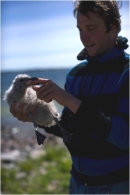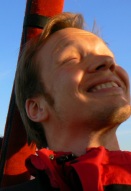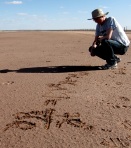The Kokkonuts!
Prof. Hanna Kokko

|
I am interested in a diverse set of evolutionary and ecological phenomena. To find out what I've been up to lately, you can check stuff on
sex, eco-evo feedbacks, parental care,
sex ratios, conflict & its population dynamic consequences,
territoriality, dispersal & migration, conservation, and
social evolution, among other topics listed here. |

|
Dr. Rob Lanfear

|
Mutation is fundamentally important in evolutionary biology, but we are quite ignorant
about its causes and consequences. For instance, we know very little about why some
species evolve faster than others. I have focussed on two related approaches to
understanding mutation: estimating mutation rates from DNA sequence data, and
using these estimates to test hypotheses about the causes and consequences of
mutation.
Right now, Iím working on methods that use DNA sequences to estimate the
importance of particular mutagens in evolutionary history. Iím hoping that
these methods will allow us to ask how mutagens influence species distributions
and life histories, and to infer how species respond to differ mutagens over
evolutionary time. In addition, Iím hoping develop models to predict how mutation
rates influence life history tradeoffs, and to use various approaches to test these predictions.
To find out more about the stuff I do, visit www.robertlanfear.com
|

|
Dr. Kate Umbers

|
My research interests, borne out of a life-long love of natural history, are varied
but follow an evolutionary theme. Focusing on poorly-known species, I am keen to explain
the adaptive significance of bizarre traits like unusual colouration, extreme appendages
and complex behavioural repertoires. I feel that this approach can inform the study of
evolution because delving into examples that deviate from the trend allows us to learn
from the exceptions rather than amassing more evidence in support of the rule.
I use a multitude of techniques to explore evolutionary phenomena including
various molecular tools, manipulative behavioural assays, spectrophotometry
and theory. I also have a strong conservation ethic and enjoy answering
questions about the genetic status of species and their populations.
Through my research I aim to understand more about evolutionary relationships,
mating systems, dispersal and viability of threatened and poorly-known
species. I have a view to drawing attention to the importance of looking
beyond the familiar.
For more info, click here
|

|
Dr. Luke Holman

|
I am interested in evolutionary ecology, particularly of cooperation, signals,
recognition and sex. I aim to test and generate evolutionary theory by combining
experiments and mathematical models.
Much of my work has focused on queen-worker chemical communication in social
insects. With colleagues in Copenhagen I isolated the first ant queen pheromone,
a cuticular hydrocarbon with the catchy name 3-methylhentriacontane. The pheromone
suppresses development of worker antsí ovaries and signals that the queen is
doing her job and laying plenty of eggs. I am keen to find out why this particular
chemical evolved to symbolise royalty, and why queens do not exaggerate their
fertility.
I have also worked on unusual sperm morphology, terminal sexual signals, mechanisms
of sperm competition and the persistence of genetic kin recognition. In my present
position, I would like to apply new empirical and theoretical approaches to a
range of interesting evolutionary questions.
To find out more, click here!
|

|
Dr. Allison Shaw

|
My research interests lie at the intersection between evolution,
behavior, ecology, and theory -- in particular I develop models to
understand how organisms use movement to adapt to their environments.
I aim to construct theory that spans taxonomic and ecosystem barriers
in order to minimize the incorporation of implicit biases, draw parallels
between disparate groups, and generate predictions that can be tested in a
variety of species. I am currently thinking about the extent to which
dispersal can be used to help individuals find mates at low density
and mitigate Allee effects. I also have ongoing collaborations on
topics such as animal migration, life history evolution, invasion speed,
sex-based differences, impact of climate on movement, evolution of complex
systems, and hope to start a variety of other collaborations during my time
as a postdoc. For more info click here.
|

|
Dr. Kim Jaatinen

|
My research has largely focused on the reasons for aggregating into social units, and on the resolution of social conflicts. I combine empirical field studies with molecular and theoretical tools to clarify the reasons for joining groups and for cooperating within groups. The varying quality of individuals also intrigues me. Iím especially keen on figuring out the reason for individual quality variation and, not surprisingly, how this variation ties in with social dominance and division of group assets.
I joined the Kokkonuts to look closer at the effect predation may have on the rise of social aggregations. Together with Hanna and Jussi we aim to clarify the current view on the adaptiveness of group living in the face of danger.
I do get distracted by other interesting research as well: the rise of relatedness in conspecific brood parasitism, effects of climate change on avian migration strategies, sex allocation strategies and sex biased populations, population dynamics of harvested wildlife as well as wetland conservation measures.
|

|
Andrew Kahn

|
I am working on my PhD co-supervised by Hanna and Michael Jennions.
I completed a B. Sc (hons., adv.) in 2010, also at the ANU.
I use a combination of empirical and theoretical work to study the consequences of sexual selection on the evolution of animal behaviours and life-histories.
I am particularly interested in the evolution of male parental care (especially in fish) and male cryptic choice / strategic courtship.
Currently, I am in Northern Australia studying female mating preferences and male courtship effort in a fiddler crab.
When Iím not working I spend as much time as possible fishing, taking photos or playing ultimate frisbee.
|

|
Dr. Jussi Lehtonen

|
I have always been fascinated by biology, mathematics and physics. I am now lucky enough to be working in a field where I can regularly combine the first two of these, by applying various mathematical methods to biological problems.
I am interested in a broad range of questions in evolutionary biology and ecology. I have recently completed my PhD, titled ĎEvolutionary and ecological implications of sexual reproductioní. The topics of my thesis include the evolutionary costs of sex, the evolution of anisogamy (i.e. the origin of males and females), sexual conflict, positive feedback in evolutionary processes, and sexual parasitism such as gynogenesis and androgenesis.
Other questions that I am interested in include social evolution, brood parasitism, predator avoidance by forming social groups, synchronous life-cycles, the consequences of sex ratio distorters and the causes of variation in rates of evolution.
|

|
Anna Harts

|
I joined the Kokkonuts in 2012. My research is focused on the evolution and behavior of sexually
reproducing populations. I use mathematical and simulation models to demonstrate the importance
of both males and females in relation to mating systems and sexual selection. At the moment
I work on two topics, mate-guarding, e.g. how males should optimize their mate-guarding duration
in relation to male-male competition and mate availability, and dispersal, how dispersal and local
adaptation can influence population demography. Other topics I am interested in include temperature
dependent sex determination, parental care, the evolution of viviparity and mate choice.
|

|
Jonathan Henshaw

|
I am working on a PhD with Hanna and Mike Jennions as supervisors. I use mathematical models to try to make sense of evolution, with a particular focus on sex allocation, sex roles, mate choice, and competition between gametes.
At the moment I am interested in why some species disperse their gametes in the air or water before fertilisation, while others keep them close to their bodies. Why do some marine animals release both sperm and eggs, while others release only sperm? Why do terrestrial plants release pollen but never ovules?
I am also working on understanding why some hermaphrodites Ďtradeí their gametes and how this might have originally come about.
|

|
Dr. Marjo Saastamoinen

|
My background is in studying life-history ecology and evolution in a spatial context.
Much of my research has focused on dispersal and related life history traits. I am
also interested in the influence that developmental conditions play on individual
physiology and life history. The main aim of my recent work has been to understand
the possible strategies involved in coping with environmental stress, such as food
limitation, in the wild populations of the Glanville fritillary butterfly. I am
also using quantitative genetics, candidate genes and more recently gene expression
approaches to understand the role of genes in shaping phenotypic variation in
developmental and life history traits under both laboratory and natural environmental
conditions. The aim of my 3-month research visit to ANU is to build an individual
based simulation model in collaboration with Hanna. We are interested in
understanding the influence of sex-biased dispersal on the evolution of
phenotypic plasticity in spatially structured environments.
|

|










